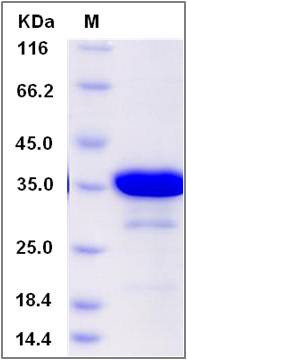Human SAA4 Protein (GST Tag)
C-SAA,CSAA,SAA4
- 100ug (NPP4242) Please inquiry
| Catalog Number | P11311-H09E |
|---|---|
| Organism Species | Human |
| Host | E. coli |
| Synonyms | C-SAA,CSAA,SAA4 |
| Molecular Weight | The recombinant human SAA4 /GST chimera consists of 344 amino acids and has a predicted molecular mass of 39.8KDa. It migrates as an approximately 36 KDa band in SDS-PAGE under reducing conditions. |
| predicted N | Met |
| SDS-PAGE |  |
| Purity | > 93 % as determined by SDS-PAGE |
| Protein Construction | A DNA sequence encoding the mature form of human SAA4 (P35542) (Glu19-Tyr130) was fused with the GST tag at the N-terminus. |
| Bio-activity | |
| Research Area | Cardiovascular |Blood |Acute Phase Reactants |
| Formulation | Lyophilized from sterile PBS, 0.5% Triton X-100, pH 7.4 1. Normally 5 % - 8 % trehalose, mannitol and 0.01% Tween80 are added as protectants before lyophilization. Specific concentrations are included in the hardcopy of COA. |
| Background | SAA4 is a member of the SAA family.SAA proteins are family of apolipoproteins of high density lipoprotein (HDL). They can be separated into two distinct groups. First group (SAA1, SAA2, and SAA3) consists of acute phase reactant whose expression level increase in the blood in a response to trauma, infection, inflammation, and neoplasia. These acute phase SAAs associates with HDL during inflammation and remodel the HDL particle by displacing Apo-A1. The second distinct group consists of SAA4 and SAA5 which exist as the minor apolipoproteins on HDL, but this group of SAA constitutes more than 90% of all the SAA during homeostasis, and it is thought to play a role in the normal functioning of the HDL particle. SAA4 is a constitutively expressed protein which expressed only in humans and mice.It is connected almost completely with lipoproteins of the high density range. The physiological function of SAA4 is unknown, and its serum concentration has no association with those of other major apolipoproteins. |
| Reference |
